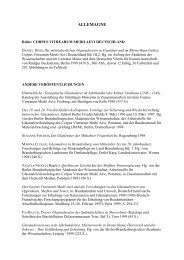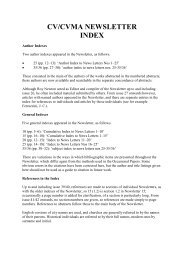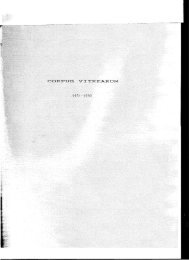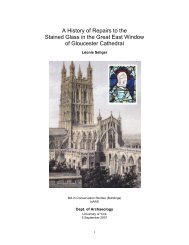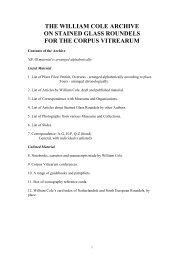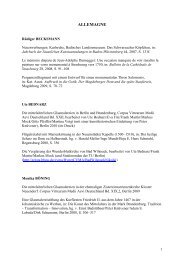BristolConference - Corpus Vitrearum Medii Aevi
BristolConference - Corpus Vitrearum Medii Aevi
BristolConference - Corpus Vitrearum Medii Aevi
Create successful ePaper yourself
Turn your PDF publications into a flip-book with our unique Google optimized e-Paper software.
The chapel's distinctive T-plan - a liturgical<br />
choir with antechapel- may have derived from<br />
Merton College, though it is possible that a<br />
longer nave was originally intended but<br />
abandoned because the necessary extra land<br />
could not be acquired. The west wall masonry<br />
is not bonded in with the north and south walls,<br />
suggesting that work came to a halt here and<br />
that the west wall was built at a slightly later<br />
stage. Although Perpendicular tracery first<br />
appeared in Oxford in 1364 (at Canterbury<br />
College, now lost), elsewhere in the city<br />
Decorated forms were still commonly<br />
employed. Wynford introduced a 'gridiron'<br />
pattern on a large scale for the first time.<br />
THE STAINEDGLASS<br />
The glazing was executed by the workshop of<br />
Thomas Glazier,who is known to have dined at<br />
New College regularly from 1386to 1398,and<br />
more sporadically thereafter until his death in<br />
1422. Although attempts have been made to<br />
show that Thomas worked at St Stephen's<br />
Chapel and St George's Windsor, nothing is<br />
known for certain about his work before c.1380,<br />
when it is assumed that he began the New<br />
College scheme. Wykeham appears to have<br />
commissioned work from him on a more or less<br />
continuous basis throughout the 1380s and<br />
1390s. He is known to have worked at<br />
Winchester College, where he is<br />
commemorated in the east window, and at<br />
Highclere, Hants. It is probable that he also<br />
provided glazing for the nave of Winchester<br />
Cathedral after Wykeham's death (1404),paid<br />
for by a substantial bequest in the Bishop's will.<br />
Date. The chapel was glazed in two campaigns,<br />
the first (c.1380-86)comprising all but the west<br />
window which, as has been indicated, may not<br />
have been constructed until it became clear that<br />
a nave was not viable. Stylistically, the west<br />
window glazing (no longer at New College)<br />
appears to date from the 1390s,having much in<br />
common with that at Winchester College<br />
(executed between 1393and 1396).<br />
Iconography. The majority of the extant<br />
medieval glazing is now to be found in the<br />
antechapel and consisted almost entirely of<br />
standing figures in niches. The antechapel aisle<br />
windows, containing a series of patriarchs and<br />
prophets, embodied the Old Law. The New<br />
Law was represented in the two antechapel<br />
east windows by no fewer than four depictions<br />
of the Crucifixion and, in the upper lights, a<br />
series of Apostles. Flanking the entrance to the<br />
choir,in the tracery lights, were a Coronation of<br />
the Virgin (sVI) and an image of Wykeham<br />
kneeling before Christ (nVI). A Jesse Tree and<br />
Doom in the west window made explicit the<br />
link between the Old and New Testaments.<br />
Appropriately, given the Founder's purpose,<br />
the Life of the Church was represented in the<br />
choir with an extensive series of saints,<br />
including many clerics and monarchs. The<br />
choir and antechapel programmes were linked<br />
by a series of the Nine Order of Angels in the<br />
tracery lights.<br />
Wykeham dedicated both of his colleges to the<br />
Virgin Mary, and although she appears in<br />
sculpture at New College, there seems to have<br />
been no emphasis on Marian iconography in<br />
the glazing. The 'back to back' layout of the<br />
chapel and hall deprives the chapel of its east<br />
window. There was instead a great reredos,<br />
which played a critical role in the overall<br />
iconographic programme. The 14 th -century<br />
reredos is lost but the present structure by Sir<br />
George Gilbert Scott gives some sense of the<br />
scale of the original. Surviving fragments of<br />
sculpture from Wykeham's reredos include an<br />
Annunciation, Nativity and Coronation of the<br />
Virgin, suggesting that it provided the narrative<br />
and Marian elements which are absent from the<br />
stained glass.<br />
The coherent iconographic scheme must have<br />
been determined by Wykeham and bears<br />
similarities to that at Winchester College,where<br />
a Jesse Tree and standing figures of prophets,<br />
Apostles and saints predominate. Across the<br />
base of each window is an inscription, more or<br />
less complete: 'Orate pro Willelmo de Wykeham<br />
episco Wyntoniensis fundatore Collegii'.<br />
Style. Given Wykeham's status, wealth and<br />
connections with the Court it is likely that the<br />
surviving glass at New College represents the<br />
best of English glass painting in the 1380s.It is<br />
highly accomplished work, which employs,<br />
within the framework of a fairly simple overall<br />
design, a rich and varied register of decorative<br />
detail, from the intricate motifs ornamenting<br />
the draperies to the inventive roofscapes of the<br />
canopywork. Its technical sophistication is<br />
evident throughout, in the expert handling of<br />
silver stain, for example and in the 3-<br />
dimensional effects created through the<br />
application of stipple shading and washes to<br />
the figures and the architectural framework.<br />
Despite the high quality of the work, it is clear<br />
that Thomas Glazier was - at this stage -<br />
operating within the mainstream of<br />
contemporary English painting. The decorative<br />
motifs and architectural framework are, as<br />
Richard Marks has shown, paralleled in smaller<br />
36



